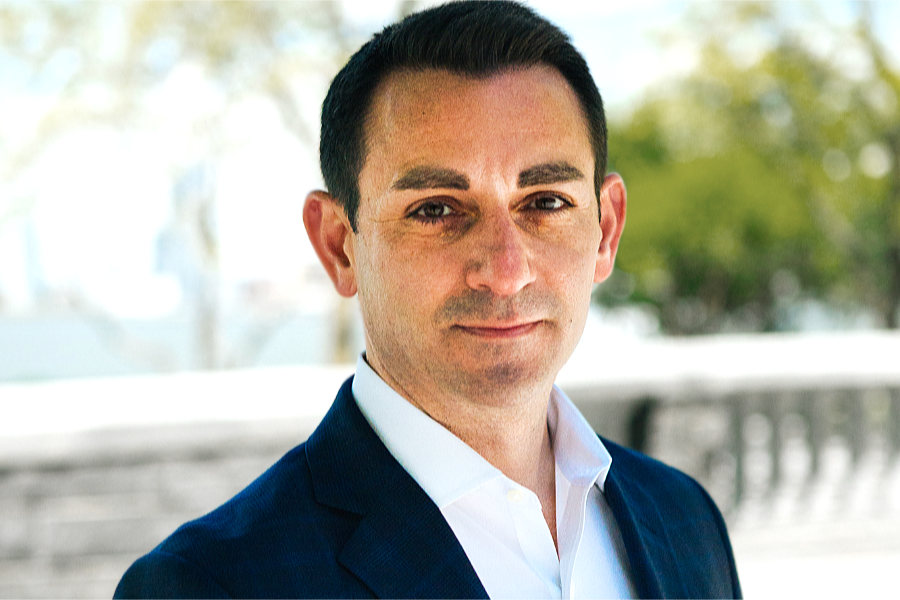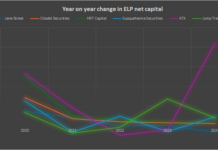
Brad Levy, chief executive of Symphony, is positioning the company to help the financial industry navigate a ‘supercycle’ of change driven by the “three V’s” of volatility, velocity and variability.
Levy took on his role as head of the financial markets infrastructure and technology platform in June 2021 replacing David Gurlé, who founded Symphony in 2014.
He told Markets Media’s Shanny Basar: “We’re going through a massive disruption cycle and the three V’s which make up the ‘vol monster’ – increased volatility at a higher velocity produces a wider variability in results. The winners will get bigger.”
In a think piece, Risk, Transformation & Trust:It will be a little different this time, Levy said: “A wider spread of potential outcomes creates bigger winners and a longer tail of losers. Iconic examples like Amazon, Blockbuster, Blackberry, and Apple illustrate this.”
He described Symphony’s role in the centre of decentralized finance (DeFi) as working together with other members of the community to lay the tracks and roads for the future, putting cars on them and adding people in those cars. “We’re laying down all the new infrastructure,” he said.
As business becomes decentralized they have to operate at the “Edge” where workflows become larger, more complex, and distributed across multiple teams. Levy said the Edge consists of three components: applications, people and data.
“The Edge is not the Cloud. It isn’t even a specific place,” he added. “It’s anywhere that the person is, and technology itself is continually pushing all of us towards this decentralized Edge.”
One of the biggest changes for the financial industry will be moving from linear batch processes to real-time, which can only be enabled by technology.
“There is no market opening for bitcoin as it is always on, so it is real-time versus batch,” added Levy. “So many things are realigning at the same time which is why this is a supercycle of change.”
Levy wrote that successful companies are defined by the common precepts of high volume, quick reaction and low processing time.
“For all companies in the long run it’s critical to be able to achieve all three, even in the most volatile environments, and that is extremely difficult,” he added.
In 2020 Symphony adopted a three-year vision labelled “prime” which will eventually lead in 2025 to the new world of the multiverse, a mixture of digital and analogue
“By 2025 I truly believe that we’re going to be in something that looks more symbiotic and less technology versus people,” he added. “The multiverse will exist for the people that want it.”
Levy said Symphony believes in taking some legacy technology forward, where it is necessary.
“Not all of the technology of the past is bad and some can be repurposed,” he added. “It can be secure and very safe. We just want to shrink it and attach it to the cloud.”
Collaboration
Symphony ended 2021 with more than 1,000 financial institutions as clients according to the firm and it executed on partnerships and two acquisitions.
In June 2021 Symphony announced the acquisition of Cloud9 Technologies, a trader voice and electronic communication business, and in August the firm announced the purchase of StreetLinx, a counterparty mapping platform, in order to offer secure identity verification.
The firm also signed a multi-year deal with Google Cloud and established partnerships with a number of fintechs.
Levy described the Google cloud agreement as a “pretty big deal.” He said: “It’s about the cloud but it’s really about modular collaboration and interoperability with artificial intelligence and natural language processing.”
He explained that firms need to work together in the new collaboration economy as a number of technologies have to converge in order for success. Symphony users can also now start or join Zoom calls from any Symphony chat room or conversation at the click of a button.
“We have partnered with megatechs such as Google, we are involved in the relationship between the ledger and the remote worker with Zoom, and we provide access to a chain of data over time,” he added. “I’m not sure anybody thinks of these as related.”
Symphony will continue to extend collaboration this year and form more partnerships, such as with financial market infrastructures, which could include entities such as BlackRock’s Aladdin platform or data provider FactSet.
In December 2021 FactSet announced an acquisition of CUSIP Global Services from S&P Global for $1.9bn. CUSIP Global Services manages a database to uniquely identify more than 50 million global financial instruments and is the exclusive provider of CUSIP and CINS identifiers globally, as well as the official numbering agency for ISIN identifiers in the US. FactSet said the acquisition will significantly advance its open data strategy.
Levy said: “FactSet is interesting, especially as they have just acquired CUSIP, which is even more interesting.”
In addition, in 2021 the company rolled out Symphony 2.0, the second generation of its core collaboration platform which it said was built in close partnership with financial firms to address their workflow needs.
©Markets Media Europe 2022
<a href=”#top”></a>
<hr />
©Markets Media Europe 2025












